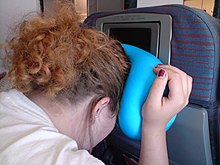Brace position
As Brace position or safety position or crash position (crash Attitude) is in the aviation a posture in airplane seat designated. This improves the chances of survival in aircraft crashes and emergency landings for the flight passenger , as the head and torso are trapped between the backrests of the rows of seats. The English word brace means to clamp, to cling. In the event of a threat of a crash or an emergency landing, the flight captain or the cabin crew asks the flight passengers to take up this safety position with the instruction “take a safety position” or “brace for impact” or “brace, brace”.
purpose
Taking a clamped posture in anticipation of an aircraft accident serves to protect against broken bones and internal injuries . This also indirectly increases the chance of survival compared to burns , since a mobile passenger may still be able to leave a burning aircraft.
Death from burn injuries is a common cause of death in aircraft crashes, as in many cases kerosene is still present in the aircraft tanks, which is distributed after the crash and ignites on the hot engines.
Briefing
In commercial aircraft , it has proven to be useful to advise passengers on how to behave in a concrete manner in the event of an emergency. Pilots and flight attendants call on passengers to behave in this way if an air emergency occurs which makes a controlled onward flight no longer possible, but an emergency landing , ditching or the crash of the aircraft must be expected.
Clamp position
The passenger should push their pelvis back as far as possible, pull their hip belt very tight, bring their feet and head as far forward as possible, leaning their foreheads against the backrest of the front seat if necessary and placing their hands next to or above their head. With the backrest in a vertical position, the belt tightens around the pelvic bone and the risk of it causing internal injuries in the abdomen is reduced. The table is folded up in dangerous situations in order to minimize the risk of injury and to enable the aircraft cabin to be exited quickly.
The purpose of the clamp position is to clamp the body as firmly as possible between the rows of seats so that it is not thrown around. The head can be additionally protected by hands and arms.
See also
Individual evidence
- ↑ http://www.daserste.de/wwiewissen/beitrag_dyn~uid,hkrdkweqxs3xts4t~cm.asp ( Memento from February 6, 2008 in the Internet Archive )
- ↑ Passengers spend an hour with their heads on their knees. In: Der Spiegel, December 16, 2009
- ↑ wwiewissen at ARD
